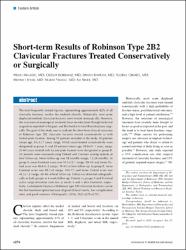Short-term results of robinson type 2B2 clavicular fractures treated conservatively or surgically

Göster/
Erişim
info:eu-repo/semantics/openAccessTarih
2016Yazar
Malkoç, MelihKorkmaz, Özgür
Bayram, Erhan
Örmeci, Tuğrul
İşyar, Mehmet
Yılmaz, Murat
Şeker, Ali
Üst veri
Tüm öğe kaydını gösterKünye
Malkoç, M., Korkmaz, Ö., Bayram, E., Örmeci, T., İşyar, M., Yılmaz, M. ve Şeker, A. (2016). Short-term results of robinson type 2B2 clavicular fractures treated conservatively or surgically. Orthopedics, 39(2), E276-E279. https://dx.doi.org/10.3928/01477447-20160201-04Özet
The most frequently treated injuries, representing approximately 82% of all clavicular fractures, involve the midshaft clavicle. Historically, most acute displaced midshaft clavicular fractures were treated nonsurgically. However, the outcomes of nonsurgical treatment have recently been thought to be not as good as expected in the past, and the trend is to treat these fractures surgically. The goal of this study was to evaluate the short-term clinical outcomes of Robinson type 2B2 clavicular fractures treated conservatively vs with locked plate fixation. Among 59 patients included in the study, 30 patients (mean age, 45 +/- 13.7 years; range, 30-62 years) treated conservatively were designated as group A, and 29 patients (mean age, 38.8 +/- 11.1 years; range, 20-60 years) treated with locked plate fixation were designated as group B. All patients were evaluated using Oxford and Constant scoring systems at final follow-up. Mean follow-up was 18 months (range, 12-24 months). In group A, mean Constant score was 70.5 +/- 15.1 (range, 98-43) and mean Oxford score was 46.6 +/- 1.3 (range, 49-44) at final follow-up. In group B, mean Constant score was 89.2 +/- 8 (range, 100-77) and mean Oxford score was 46.5 +/- 1.2 (range, 48-44) at final follow-up. Callus was detected radiographically in both groups at 6-week follow-up. Patients in groups A and B started active range-of-motion exercises at weeks 6 and 3 after treatment, respectively. Locked plate fixation of Robinson type 2B2 clavicular fractures can be the first treatment option because of good clinical results, low complication rates, and good cosmesis.
WoS Q Kategorisi
Q4Scopus Q Kategorisi
Q2Kaynak
OrthopedicsCilt
39Sayı
2Koleksiyonlar
- Makale Koleksiyonu [3751]
- PubMed İndeksli Yayınlar Koleksiyonu [4203]
- Scopus İndeksli Yayınlar Koleksiyonu [6522]
- WoS İndeksli Yayınlar Koleksiyonu [6585]

















